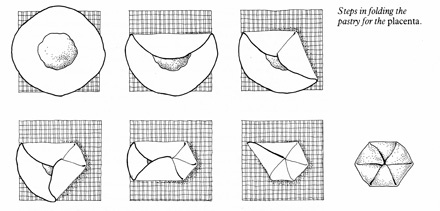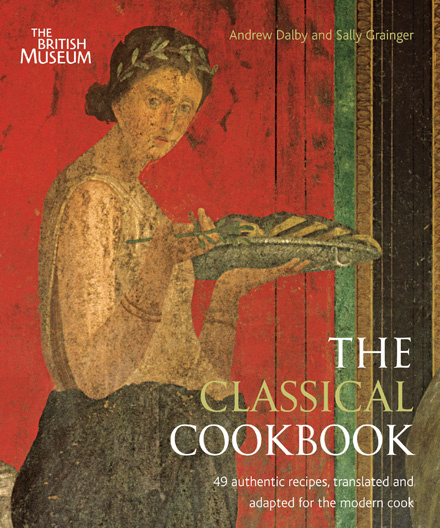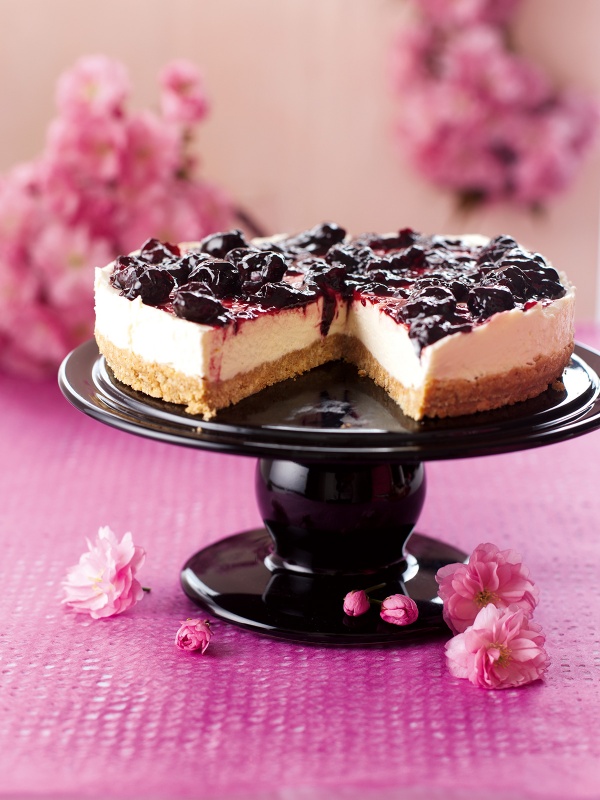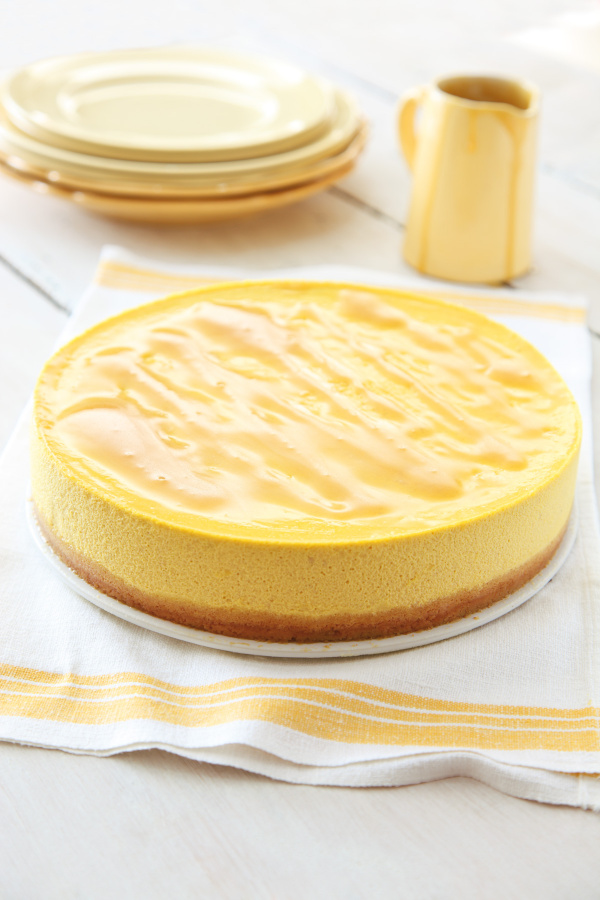Layered Cheesecake
by Andrew Dalby and Sally Grainger, featured in The Classical Cookbook Published by The British Museum PressIntroduction
This remarkable cake comes from Cato’s farming book. The name is Greek (and it had nothing to do with the modern meaning of placenta, invented by a seventeenth-century scientist). In Greek the word could often mean a flat cake with a pastry base; goat’s milk cheese and honey were among typical ingredients. A Greek comedy included a brisk exchange between a wordy gourmet and a down-to-earth eater:
The streams of the tawny bee, mixed with the clotted river of bleating she-goats, placed upon a flat receptacle of the virgin daughter of Zeus, delighting in ten thousand delicate veils - or shall simply say cake for cake.
Roman placenta, like libum, was not only a delicacy for humans but also a sacrificial cake offered on temple altars. The Roman poet Horace tells of a temple slave who ran away because he was sick of honeyed placenta and wanted some good plain bread. Cato’s Latin placenta is a single, very specific and very complicated recipe. It is likely that Cato was confused by the recipe he was copying. The ratio of ingredients doesn't always work: the 2lb of soaked semolina will not absorb 4lb of flour to make a dough for the internal layers; and the base dough, when rolled out, will be several feet across! The thickness of the outer covering is crucial: if made to Cato’s recipe, it must have been fairly thick or the cake would have been too large to bake. To make a dinner-party placenta we had better ignore the ratios he gives and simply follow the method. The following recipe, then, is a small delicate version of Cato’s cake that could have graced a Roman banquet.
This remarkable cake comes from Cato’s farming book. The name is Greek (and it had nothing to do with the modern meaning of placenta, invented by a seventeenth-century scientist). In Greek the word could often mean a flat cake with a pastry base; goat’s milk cheese and honey were among typical ingredients. A Greek comedy included a brisk exchange between a wordy gourmet and a down-to-earth eater:
The streams of the tawny bee, mixed with the clotted river of bleating she-goats, placed upon a flat receptacle of the virgin daughter of Zeus, delighting in ten thousand delicate veils - or shall simply say cake for cake.
Roman placenta, like libum, was not only a delicacy for humans but also a sacrificial cake offered on temple altars. The Roman poet Horace tells of a temple slave who ran away because he was sick of honeyed placenta and wanted some good plain bread. Cato’s Latin placenta is a single, very specific and very complicated recipe. It is likely that Cato was confused by the recipe he was copying. The ratio of ingredients doesn't always work: the 2lb of soaked semolina will not absorb 4lb of flour to make a dough for the internal layers; and the base dough, when rolled out, will be several feet across! The thickness of the outer covering is crucial: if made to Cato’s recipe, it must have been fairly thick or the cake would have been too large to bake. To make a dinner-party placenta we had better ignore the ratios he gives and simply follow the method. The following recipe, then, is a small delicate version of Cato’s cake that could have graced a Roman banquet.

Share or save this
Ingredients
Serves: 6
- 60 grams semolina
- 170 grams plain flour
- 340 grams ricotta cheese or full-fat cream cheese
- 90 grams plus ½ cup / 100g clear honey
- bay leaves
- ⅓ cup semolina
- 1 ½ cup all-purpose flour
- 12 ounces ricotta cheese or full-fat cream cheese
- 3 tablespoons plus ½ cup / 100g clear honey
- bay leaves
Method
Layered Cheesecake is a guest recipe by Andrew Dalby and Sally Grainger so we are not able to answer questions regarding this recipe
- Place the semolina in a bowl with enough cold water just to cover it. Allow to stand for 1 hour. Sift 4 oz (3/4 cup / 120g) flour into a bowl and form a dough with about 2 tablespoons (30ml) cold water. Knead well and allow to rest. Strain the semolina and remove as much of the water as possible; place in a bowl and knead in 2 oz (1/3 cup / 60g) flour. Form a dough and leave to rest.
- Beat the cheese, add 3 tablespoons (90g) honey and leave to one side. Divide the semolina dough into 6 equal pieces. Roll out and also pull each one into a circle roughly 8in (20cm) across. Take a cake tin or ring of that size and cut each circle into a uniform shape and discard the thicker edges. Carefully lay them on a lightly floured table to dry.
- When the pastry is dry take the flour and water dough and roll it out with plenty of flour into a circle about 18in (45cm) across. Half way through switch to using the back of your hands to pull the dough out. It should resemble strudel paste in thickness.
- Now you can begin to build the cake. Grease a large baking tray with olive oil and place 3 or 4 large fresh bay leaves on it. Carefully lift the large flour-dough base on to the baking tray and let it drape over the edge. Place a tablespoon of the cheese/honey mixture on the base and spread it out. Place one layer of the semolina pastry on to this and put another tablespoon of the honey mixture on this. Repeat until you have used up the honey and cheese; finish with a layer of pastry. Your pastry base should have at least 5in (13cm) of dough each side of the stack of honey layers. Standing before the cake, pick up the far edge of the base and pull it towards you and place it across the top layer. Move your hand down to the right and pull another part of the edge towards the centre; this will create a fold which you can repeat all round the cake. The final edge needs to be tucked in. Gather the pastry at the top and twist it off, leaving a small knob. Cover with your alternative cover and bake in a pre-heated oven at 425°F (220 °C/gas mark 7) for 45 minutes to 1 hour until golden-brown and crisp around the edge. Allow to cool slightly and place in a large dish with a lip. Pour the rest of the warmed honey over the cake and allow it to soak in for 10 minutes. Serve warm.
- Place the semolina in a bowl with enough cold water just to cover it. Allow to stand for 1 hour. Sift 4 oz (3/4 cup / 120g) flour into a bowl and form a dough with about 2 tablespoons (30ml) cold water. Knead well and allow to rest. Strain the semolina and remove as much of the water as possible; place in a bowl and knead in 2 oz (1/3 cup / 60g) flour. Form a dough and leave to rest.
- Beat the cheese, add 3 tablespoons (90g) honey and leave to one side. Divide the semolina dough into 6 equal pieces. Roll out and also pull each one into a circle roughly 8in (20cm) across. Take a cake tin or ring of that size and cut each circle into a uniform shape and discard the thicker edges. Carefully lay them on a lightly floured table to dry.
- When the pastry is dry take the flour and water dough and roll it out with plenty of flour into a circle about 18in (45cm) across. Half way through switch to using the back of your hands to pull the dough out. It should resemble strudel paste in thickness.
- Now you can begin to build the cake. Grease a large baking tray with olive oil and place 3 or 4 large fresh bay leaves on it. Carefully lift the large flour-dough base on to the baking tray and let it drape over the edge. Place a tablespoon of the cheese/honey mixture on the base and spread it out. Place one layer of the semolina pastry on to this and put another tablespoon of the honey mixture on this. Repeat until you have used up the honey and cheese; finish with a layer of pastry. Your pastry base should have at least 5in (13cm) of dough each side of the stack of honey layers. Standing before the cake, pick up the far edge of the base and pull it towards you and place it across the top layer. Move your hand down to the right and pull another part of the edge towards the centre; this will create a fold which you can repeat all round the cake. The final edge needs to be tucked in. Gather the pastry at the top and twist it off, leaving a small knob. Cover with your alternative cover and bake in a pre-heated oven at 425°F (220 °C/gas mark 7) for 45 minutes to 1 hour until golden-brown and crisp around the edge. Allow to cool slightly and place in a large dish with a lip. Pour the rest of the warmed honey over the cake and allow it to soak in for 10 minutes. Serve warm.






Tell us what you think
Thank you {% member.data['first-name'] %}.
Explore more recipesYour comment has been submitted.